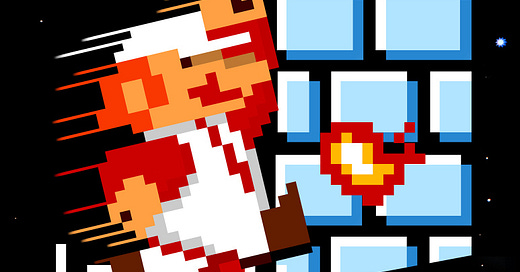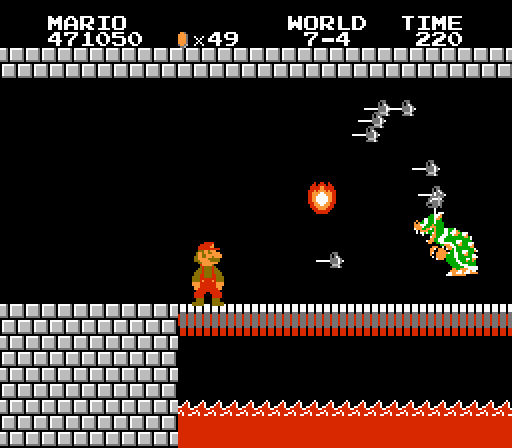Nintendo is Great is a Substack devoted to playing and exploring every game ever released for a Nintendo console/handheld in chronological order. Some posts are free, some are for paid subscribers only. Don’t forget to sign up below. Thanks for reading!
Super Mario Bros.
PUBLISHER/DEVELOPER: Nintendo
RELEASE DATE: Sept. 13th, 1985 (JP), Oct. 18th, 1985 (US), May 15th, 1987 (EU)
ALSO AVAILABLE ON: Famicom Disk System, X1, PC-88, Arcade, SNES (via Super Mario All-Stars), Game Boy Color, Gamecube (via Animal Crossing), Game Boy Advance, Virtual Console (Wii, 3DS, Wii U), Wii (via Super Mario All Stars: 25th Anniversary), NES Classic, Switch (via Arcade Archives), Nintendo Switch Online
Mario starts off small and weak. Doubts plague his heart. He shouldn’t be here. This isn’t his world. Eventually, he moves forward, his spirits buoyed by the jaunty, optimistic background music. A Goomba rolls slowly towards him. He jumps and squashes him. Mario wonders if he should feel guilty, but those thoughts pass when he looks ahead. Blocks with question-mark symbols blink seductively in front of him. He can’t resist. He bumps the three in front of him with his fists. Two of the blocks yield coins, while the other provides a mushroom. He ingests it without thinking. Suddenly, he is taller, bigger, stronger. He runs past two large pipes in the ground, more Goombas, then stops before an open gap. Something feels different about this innocuous area. He jumps absentmindedly. A green mushroom appears out of an invisible block. He grabs it, feeling ever more confident, and leaps the gap.
Another question-mark block. This time, his prize is a neon flower. As he touches it, flames emerge from his hands. A Koopa passing by is fried instantly. He chuckles to himself, then runs forward, incinerating all impediments, collecting all the items from question-mark blocks. At one point, a star emerges. His body consumes it, and the result is pure power and momentum. Mario runs forward, full of energy and life. Goombas and Koopas are cut down simply by touching him. Pipes and blocks are no match for his leap. He wants this godlike feeling to last forever, but it ends, and he’s weary.
Mario stands at the foot of a mountain, wondering what the other side holds. Wanting to rest but more curious than tired, he musters up his strength and climbs to the top. On the other side is a flagpole. Beyond it still, a small castle. While he could probably jump directly down and be fine, he decides not to plummet from this high vantage point. He takes a breath and leaps towards the flagpole, higher than ever before. The gently waving flag passes him by. He grasps onto the middle of the flagpole before sliding to the ground. Fireworks go off in the distance as he walks towards the castle, still unsure of what’s happening with this unusual place. Confused but undaunted, he rests in the castle and waits for his hapless brother Luigi before moving forward.
On October 18th, 1985, Super Mario Bros. came out of nowhere and changed the gaming landscape as we knew it. No more one-screen levels. The screen scrolls smoothly with the action. Mario runs, jumps, and soars from left to right with outstanding control and surprising grace. There are thirty-two separate, distinct levels. Yes, many of these levels reuse the same assets, but no two levels are designed exactly the same.
Playing Super Mario Bros. feels like freedom. Because each level isn't restricted to one screen, Nintendo spaces out their design elements so they're not on top of each other. You notice this immediately in World 1-1. Pipes are evenly placed throughout. Enemies aren't all clustered together. If Mario wants to, he can run and leap over enemies, blocks, pipes, etc. Want to climb up onto the bricks at the top of the level? You can do it. Want to smash every brick, collect every coin, kill every enemy? Go for it. Want to avoid everything? That's your prerogative.
SMB has several different types of levels, including: above ground, underground, underwater, treetops, and castles. There are bizarre one-off levels. 4-3 places you atop a mushroom forest. 6-3 paints everything completely white. Is the white supposed to be snow? Ash? Levels 2-3 and 7-3 place floating bridges across the sky and launch Cheep-Cheeps into the air, while Mario runs for his life. The sheer variety of level design was unparalleled in 1985.
Power-ups? Yeah, Mario's got 'em on lock. You know what they do: the mushroom makes him grow, the fire flower provides fiery long-range projectiles, and the golden star briefly turns him invisible. Power-ups are commonplace and expected now. In 1985, few games included elements that enhanced the main protagonist of their games.
Music and sound play a crucial role here, as well. The main overworld theme is so ubiquitous and timeless that even people who don't play video games know what it sounds like. The underworld, underwater, and castle themes aren't as memorable, but their limited melodies effectively convey their respective landscapes. The sound effects – Mario jumping, squashing a Goomba, grabbing a coin, pausing the game – are perfect. These ditties and bleep bloops are tattooed in our brains, whether we want them to be or not.
Secrets are prevalent in the Mushroom Kingdom. Hidden power-ups, coin boxes, pipes to mini bonus rooms, warp pipes to future worlds, vines to the clouds. If you land on the flagpole at certain times, fireworks erupt over the castle. Destroying each fake Bowser with fire balls will cause their true forms to manifest. That trick in stage 3-1 where you hit the koopa shell against the block and get a million lives. The Minus World. You get the point. Super Mario Bros. begs you to explore its depths.
SMB also pioneered the perfect control setup for platformers: 'A' to jump, 'B' to attack. Many NES games would later try to implement alternate control schemes – 'Up' or 'B' to jump, for example – but none of them felt right. As such, many of the most cherished platformers on the NES and SNES use this classic control scheme.
The majority of the NES launch games were excellent in 1985, but they were also iterations on styles and genres that gamers had experienced before, either on Atari, Intellivision, or in the arcade. Super Mario Bros., while not the first side-scrolling platformer, is its own unique creation, a once-in-a-generation event, and the reason the NES changed the American gaming landscape in the late 1980s. SMB’s astonishing success proved that video games weren’t just a seasonal fad, and it laid the foundation for thousands of games that followed in its wake. Whether you consider its gameplay antiquated or not, Super Mario Bros. will forever be a timeless classic, one overflowing with creativity, joy, and life.
A+










A classic.
"The Blooper tolls for thee…" ROFL! Thank you for writing this Super Article and very nice new Substack, Dylan. ;-)
I cannot lie, I teared up a little reading this one. Mario is very, very nostalgic for me (been playing Mario games for over 40 years now). Mario is definitely one of those pure bliss type of video game experiences, similar to Pac-Man.